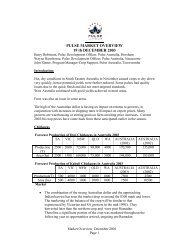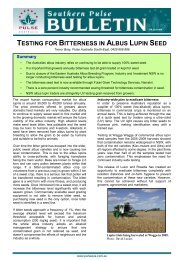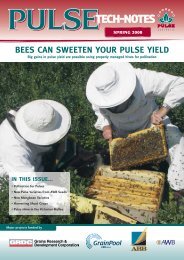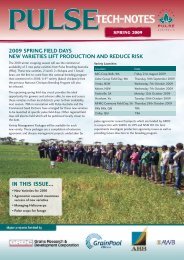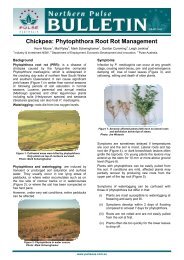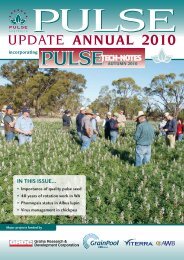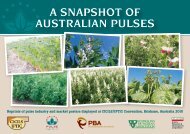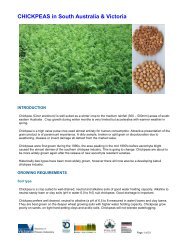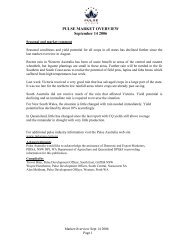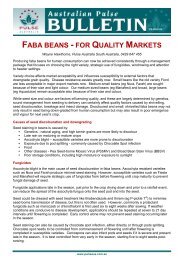Australian Grain Industry Code of Practice - Pulse Australia
Australian Grain Industry Code of Practice - Pulse Australia
Australian Grain Industry Code of Practice - Pulse Australia
Create successful ePaper yourself
Turn your PDF publications into a flip-book with our unique Google optimized e-Paper software.
Part Two —<br />
<strong>Code</strong> Requirements<br />
2.1 Product Integrity/Standards<br />
Background<br />
The <strong>Code</strong> seeks to build buyer confidence through:<br />
providing evidence <strong>of</strong> compliance with regulatory<br />
and market requirements in relation to chemicals, labelling<br />
and processing<br />
the supply chain maintaining product quality and integrity and<br />
providing traceability<br />
providing accurate descriptions <strong>of</strong> products (truth in labelling)<br />
across the supply chain<br />
Product Standards<br />
Trade in the <strong><strong>Australia</strong>n</strong> grain industry is based on a set <strong>of</strong> grain<br />
standards and contracts that enable buyers to have clarity and<br />
confidence in the products they purchase; and growers to have clarity<br />
around the requirements and pricing <strong>of</strong> the product they supply.<br />
<strong>Grain</strong> standards in <strong>Australia</strong> are published by GTA (Refer to Part<br />
5). GTA develops and distributes standards for wheat and coarse<br />
grains. The <strong><strong>Australia</strong>n</strong> Oilseeds Federation is responsible for the<br />
development <strong>of</strong> standards for oilseeds, <strong>Pulse</strong> <strong>Australia</strong> develops<br />
standards for pulses and the Queensland Agricultural Merchants<br />
develop standards for birdseed. The GTA Standards Committee scope<br />
and process is outlined in Part 5 and these <strong>Grain</strong> Standards are<br />
available from www.graintrade.org.au<br />
The GTA <strong>Grain</strong> Standards are underpinned by industry classification<br />
and accreditation systems such as for barley (Barley <strong>Australia</strong>) and<br />
wheat (Wheat Classification Council).<br />
For each new variety <strong>of</strong> malting barley bred in <strong>Australia</strong>, there<br />
is a rigorous series <strong>of</strong> evaluations and hurdles the variety must<br />
pass in order to gain accreditation as a recognised malting barley<br />
variety. After new barley varieties have been routinely screened for<br />
agronomic and processing performance by the breeding institutions<br />
they are subjected to further micro and commercial scale testing<br />
for suitability to brewing. The final accreditation section <strong>of</strong> the<br />
evaluation process takes place over two seasons to ensure a broad<br />
examination <strong>of</strong> the variety. Full accreditation is achieved after<br />
the second season’s evaluation results have been examined and<br />
approved by the <strong><strong>Australia</strong>n</strong> barley industry’s technical evaluation<br />
<strong><strong>Australia</strong>n</strong> <strong>Grain</strong> <strong>Industry</strong> <strong>Code</strong> <strong>of</strong> Conduct 11



